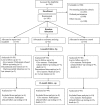Durability of Benefits From Supervised Treadmill Exercise in People With Peripheral Artery Disease
- PMID: 30587066
- PMCID: PMC6405705
- DOI: 10.1161/JAHA.118.009380
Durability of Benefits From Supervised Treadmill Exercise in People With Peripheral Artery Disease
Abstract
Background It is currently unknown whether 6 months of supervised treadmill exercise has a durable benefit on 6-minute walk performance, even after exercise is completed, in people with peripheral artery disease. Methods and Results A total of 156 participants with peripheral artery disease were randomized to 1 of 3 groups: supervised treadmill exercise, supervised resistance training, or attention control. Participants received supervised sessions during months 1 to 6 and telephone contact during months 6 to 12. Primary outcomes were change in 6-minute walk distance and short physical performance battery at 6-month follow-up and have been reported previously. Secondary outcomes were change in 6-minute walk and short physical performance battery at 12-month follow-up and are reported here. A group of 134 participants (86%) completed the 12-month follow-up. At 6-month follow-up, compared with control, 6-minute walk distance improved in the treadmill exercise group (+36.1 m, 95% CI =13.9-58.3, P=0.001). Between 6- and 12-month follow-up, 6-minute walk distance significantly declined (-28.6 m, 95% CI=-52.6 to -4.5, P=0.020) and physical activity declined -272 activity units (95% CI =-546 to +2, P=0.052) in the treadmill exercise group compared with controls. At 12-month follow-up, 6 months after completing supervised treadmill exercise, change in 6-minute walk distance was not different between the treadmill exercise and control groups (+7.5, 95% CI =-17.5 to +32.6, P=0.56). There were no differences in short physical performance battery change between either exercise group and control at 6-month or 12-month follow-up. Conclusions A 6-month supervised treadmill exercise intervention that improved 6-minute walk distance at 6-month follow-up did not have persistent benefit at 12-month follow-up. These results do not support a durable benefit of supervised treadmill exercise in peripheral artery disease. Clinical Trial Registration URL : https://www.clinicaltrials.gov . Identifier: NCT 00106327.
Trial registration: ClinicalTrials.gov NCT00106327.
Keywords: exercise; exercise training; functional capacity impairment; peripheral artery disease.
Figures


Similar articles
-
Effect of Granulocyte-Macrophage Colony-Stimulating Factor With or Without Supervised Exercise on Walking Performance in Patients With Peripheral Artery Disease: The PROPEL Randomized Clinical Trial.JAMA. 2017 Dec 5;318(21):2089-2098. doi: 10.1001/jama.2017.17437. JAMA. 2017. PMID: 29141087 Free PMC article. Clinical Trial.
-
Racial Differences in the Effect of Granulocyte Macrophage Colony-Stimulating Factor on Improved Walking Distance in Peripheral Artery Disease: The PROPEL Randomized Clinical Trial.J Am Heart Assoc. 2019 Jan 22;8(2):e011001. doi: 10.1161/JAHA.118.011001. J Am Heart Assoc. 2019. PMID: 30661439 Free PMC article. Clinical Trial.
-
Comparing 6-minute walk versus treadmill walking distance as outcomes in randomized trials of peripheral artery disease.J Vasc Surg. 2020 Mar;71(3):988-1001. doi: 10.1016/j.jvs.2019.05.058. Epub 2019 Dec 23. J Vasc Surg. 2020. PMID: 31870756 Free PMC article.
-
Exercise training for intermittent claudication.J Vasc Surg. 2017 Nov;66(5):1612-1620. doi: 10.1016/j.jvs.2017.05.111. Epub 2017 Sep 2. J Vasc Surg. 2017. PMID: 28874320 Free PMC article. Review.
-
Exercise Therapy for Peripheral Artery Disease.Curr Cardiol Rep. 2024 May;26(5):405-412. doi: 10.1007/s11886-024-02043-4. Epub 2024 May 9. Curr Cardiol Rep. 2024. PMID: 38722492 Review.
Cited by
-
MetfOrmin BenefIts Lower Extremities with Intermittent Claudication (MOBILE IC): randomized clinical trial protocol.BMC Cardiovasc Disord. 2023 Jan 21;23(1):38. doi: 10.1186/s12872-023-03047-8. BMC Cardiovasc Disord. 2023. PMID: 36681798 Free PMC article.
-
Effects of aerobic and combined training on pain-free walking distance and health-related quality of life in patients with peripheral artery disease: a randomized clinical trial.J Vasc Bras. 2023 Aug 28;22:e20230024. doi: 10.1590/1677-5449.202300242. eCollection 2023. J Vasc Bras. 2023. PMID: 37790896 Free PMC article.
-
Effectiveness of Mobile Health-Based Exercise Interventions for Patients with Peripheral Artery Disease: Systematic Review and Meta-Analysis.JMIR Mhealth Uhealth. 2021 Feb 15;9(2):e24080. doi: 10.2196/24080. JMIR Mhealth Uhealth. 2021. PMID: 33587042 Free PMC article.
-
Effects of Supervised Exercise Therapy on Muscle Function During Walking in Patients with Peripheral Artery Disease.Bioengineering (Basel). 2024 Oct 31;11(11):1103. doi: 10.3390/bioengineering11111103. Bioengineering (Basel). 2024. PMID: 39593762 Free PMC article.
-
Network Meta-Analysis Comparing the Outcomes of Treatments for Intermittent Claudication Tested in Randomized Controlled Trials.J Am Heart Assoc. 2021 May 4;10(9):e019672. doi: 10.1161/JAHA.120.019672. Epub 2021 Apr 23. J Am Heart Assoc. 2021. PMID: 33890475 Free PMC article.
References
-
- McDermott MM, Kibbe MR. Improving lower extremity functioning in peripheral artery disease: exercise, endovascular revascularization, or both? JAMA. 2017;317:689–690. - PubMed
-
- Fakhry F, van de Luijtgaarden KM, Bax L, den Hoed PT, Hunink MG, Rouwet EV, Spronk S. Supervised walking therapy in patients with intermittent claudication. J Vasc Surg. 2012;56:1132–1142. - PubMed
-
- McDermott MM, Ades P, Guralnik JM, Dyer A, Ferrucci L, Liu K, Nelson M, Lloyd‐Jones D, Van Horn L, Garside D, Kibbe M, Domanchuk K, Stein JH, Liao Y, Tao H, Green D, Pearce WH, Schneider JR, McPherson D, Laing ST, McCarthy WJ, Shroff A, Criqui MH. Treadmill exercise and resistance training in patients with peripheral arterial disease with and without intermittent claudication: a randomized controlled trial. JAMA. 2009;301:165–174. - PMC - PubMed
-
- McDermott MM, Ferrucci L, Tian L, Guralnik JM, Lloyd‐Jones D, Kibbe MR, Polonsky TS, Domanchuk K, Stein JH, Zhao L, Taylor D, Skelly C, Pearce W, Perlman H, McCarthy W, Li L, Gao Y, Sufit R, Bloomfield CL, Criqui MH. Effect of granulocyte‐macrophage colony‐stimulating factor with or without supervised exercise on walking performance in patients with peripheral artery disease: the PROPEL randomized clinical trial. JAMA. 2017;318:2089–2098. - PMC - PubMed
-
- Centers for Medicare and Medicaid Services . Decision Memo for Supervised Exercise Therapy (SET) for Symptomatic Peripheral Artery Disease (PAD) (CAG‐00449N). 2017. Available at: https://www.cms.gov/medicare-coverage-database/details/nca-decision-memo.... Accessed January 20, 2018.

